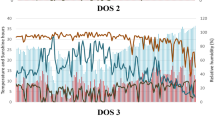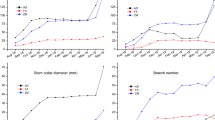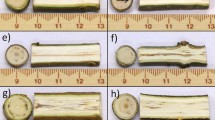Abstract
Casuarina trees are planted along the coast from Hainan province in South China to the Zhoushan Islands of Zhejiang province in Southeastern China. Three key species, Casuarina equisetifolia, Casuarina cunninghamiana and Casuarina glauca, are used as windbreaks, in agroforestry systems, and for the production of timber and fuel wood. Frankia have been studied in China since 1984. Today, Frankia research fields are very wide, and cover morphology, physiology and genetic diversity, and the application of inocula for specific purposes on poor quality sites. In this paper, we review the role of Frankia inoculations in nurseries and casuarina plantations in China and discuss the benefits of inoculation.
Similar content being viewed by others
References
Baker D, Danell KH (1986) Effects of oxygen and chloramphenicol on Frankia nitrogenase activity. Arch Microbiol 144:233–236
Brundrett M, Bougher N, Grove T, Malajczuk N (1996) Working with mycorrhizas in forestry and agriculture (ACIAR Monograph 32). ACIAR, Canberra, pp 252–253
Franche C, Laplaze L, Duhoux E, Bogusz D (1998) Actinorhizal symbioses: recent advances in plant molecular and genetic transformation studies. Crit Rev Plant Sci 171:1–28
Kang LH (1997a) Study on infective specificity by Frankia strains from Casuarinaceae. For Res 10(3):233–236
Kang LH (1997b) Study on inoculation technology and effect of inoculation with Frankia on Casuarina. For Res 10(4):341–347
Kang LH (1999) Inhibition of bacterial wilt growth by Frankia isolates from Casuarinaceae. For Res 12(1):42–46
Kang LH, Zhong CL (1999) Distribution of nodule in casuarinas plantations in southern China. Soil Environ Sci 8:212–215
Kang LH, Luo CJ, Peng YQ, Chen HC, Liu YL (1997) Study on inoculation with Frankia in Casuarina glauca. For Sci Technol Guangdong 13(2):25–28
Kang LH, Li SC, Peng YQ, Liu YL, Chen HC, Luo CJ (2000a) Study on the inoculation effects of field-grown Casuarina equisetifolia with Frankia alginate beads. For Res 13(1):39–43
Kang LH, Li SC, Peng YQ, Liu YL, Chen HC, Luo CJ (2000b) Study on the effect of fertilizing on young trees of Casuarina inoculated with Frankia. For Res 13(3):374–379
Li ZZ (2002) The studies on actinomycetes-Frankia in Fujian. PhD thesis, Fujian Agriculture and Forestry University, p 113
Li ZZ (2006) Actinomycetes Frankia in Fujian. China Environment Science Publishing, Beijing, p 128
Li YX, Wu YB (1995) Experiment on effect of inoculation with pure culture of Frankia from nodules of Casuarina. For Res 8(5):550–555
Li ZZ, Tan FL, Xu DC, Xiao XX (1998) Screening and application of superior Frankia strains of Casuarina species. J Fujian Forestry Sci Technol 25(3):56–60
Liu Q, Zhang YH (2002) Investigation of root nodules and discussion in Casuarina equisetifolia plantations in Haikou. Scientia Silvae Sinicae 38(5):175–180
Qin M, Wang YL, Cui YH, Ma QS (1990) Isolation and characteristics of Frankia from nodules of Casuarina glauca, Casuarina cristata and Allocasuarina littoralis. J Microbiol (Ch) 10(1):65–72
Tjepkema JD, Torrey JD (1983) Factors affecting vesicle formation and acetylene reduction (nitrogenase activity) in Frankia sp. CpI1. Can J Microbiol 27:815–823
Xie YQ (2009) Biological characteristics of Frankia isolated from different actinorhizal plants. Chin J Appl Environ Biol 15(5):645–649
Xie YQ, Li ZZ, Huang RZ, Huang Y, Xiao XX (2006) Effect of salt stress on growth and physiological and biochemical characteristics of Frankia. J Plant Resour Environ 15(1):9–13
Yang ZY, Zhong CL, Zhang Y (2007) Casuarina introduction trial in hot-dry river valley region. J Nanking For Univ 31:57–60
Zhang ZZ, Lopez L, Torrey JG (1984) A comparision of cultual characteristics and infectivity of Frankia isolates from root nodules of Casuarina species. Plant Soil 78:79–90
Zhang X, Shen AH, Wang QQ, Cheng YW, Lin HP, Ma LJ (2012) Identification and nitrogen fixation effects of symbiotic Frankia isolated from Casuarina spp. in Zhejiang, China. Afr J Biotechnol 11(17):4022–4029
Zhang X, Shen AG, Lin YJ, Wang QQ, Lin HP (2013) Infection and nodulation with Casuarina equisetifolia-Frankia symbiosis. J Zhejiang A F Univ 30(5):669–673
Zhong C (1993) Study on the optimum Frankia-genotype associations of casuarina seedlings. For Res 6:654–660
Zhong C (2000) Study on genetic variation of Casuarina trees. PhD thesis, Guangzhou. Research Institute of Tropical Forestry, Chinese Academy of Forestry, p 160
Zhong CL, Gong MQ, Chen Y, Wang FZ (1995) Inoculation of casuarina with ectomycorrhizal fungi, vesicular-arbuscular mycorrhizal fungi and Frankia. In: Brundett M, Dell B, Malajczuk N, Gong Mingqin (eds) Mycorrhizas for plantation forestry in Asia. ACIAR Proceedings No. 62. ACIAR, Canberra, Australia, pp 122–126
Zhong CL, Zhang Y, Chen Y, Jiang QB, Chen Z, Liang JF, Pinyopusarerk K, Franche C, Bogusz D (2010) Casuarina research and applications in China. Symbiosis 50:107–114
Zhong CL, Pinyopusarerk K, Kalinganire A, Franche C (eds) (2011) Improving smallholder livelihoods through improved casuarina productivity. In: Proceedings of the fourth international casuarina workshop, Haikou, Hainan, China, 21–25 March 2010. China Forestry Publishing House, Beijing, p 272
Acknowledgements
This work was supported by A Specific Program for National Non-profit Scientific Institutions (CAFYBB2018ZB003), Forestry Science and Technology Innovation Project of Guangdong (2014KJCX017), National Natural Science Foundation of China (NSFC No. 31470634), and the CAF International Cooperation Innovation Project. Special thanks to Mr Khongsak Pinyopusarerk (CSIRO Australian Tree Seed centre) for improving the use of English in the manuscript.
Author information
Authors and Affiliations
Contributions
Chonglu Zhong: Responsible for design and overall conduct of the paper, data collection, and preparation of the manuscript, funding acquisition, supervision, and so on. Yong Zhang: reference data collection and curation, formal analysis. Yongcheng Wei, Jingxiang Meng: reference data collection and curation. Yu Chen: reference data collection. David Bush: review and editing of the manuscript. Didier Bogusz: review of the manuscript. Claudine Franche: review and editing of the manuscript.
Corresponding author
Ethics declarations
Conflict of interest
The authors declare no conflict of interest.
Rights and permissions
About this article
Cite this article
Zhong, C., Zhang, Y., Wei, Y. et al. The role of Frankia inoculation in casuarina plantations in China. Antonie van Leeuwenhoek 112, 47–56 (2019). https://doi.org/10.1007/s10482-018-1205-7
Received:
Accepted:
Published:
Issue Date:
DOI: https://doi.org/10.1007/s10482-018-1205-7




